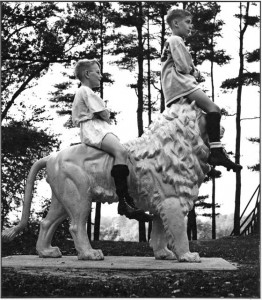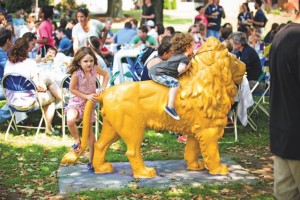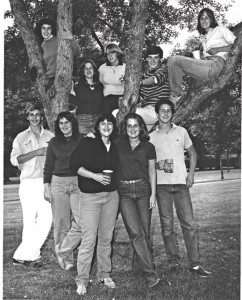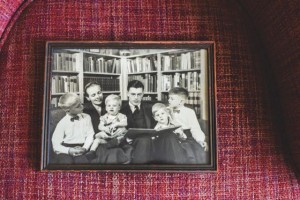 By Victoria Brett
By Victoria Brett
When she was in third grade, Kristina Conroy’s life changed dramatically. Suddenly, instead of quiet family dinners, Ms. Conroy was grabbing a plate at a dining commons and queuing up with a line of rowdy teenagers. Instead of a small backyard, an entire quad was her playground. Instead of one brother, Ms. Conroy had some 400 surrogate siblings to play with.
“I just remember getting there and feeling like I was surrounded by surrogate parents and surrogate siblings all the time,” said Ms. Conroy ’10, of her experience moving to a boarding school campus.
Such is the life of faculty and staff children, also lovingly called fac-brats, who grow up on campus, then often attend, and occasionally even return to live and work at a school like the one where they spent their childhood.
Ms. Conroy, whose family moved from California in 2000 so her father could be the athletic director and her mother a math teacher at Williston Northampton, her second boarding school home, was not like the older boarding students; she had no study hall, no check-in, and didn’t need to sign out of the dorm where she lived. Instead, she could roam the campus—under the supervision of some 200 adults, of course.
“It shaped me,” she said. “Everyone always says, ‘Why are you so good and comfortable talking to adults and strangers?’ I’ve grown up not just with my parents, but with other teachers and students.”
 This year, 18 students at the Middle and Upper Schools at Williston Northampton live with their families in dorms or houses on campus. Another 34 faculty and staff children attend as day students. And some 33 kids also live on campus, but are too young to enroll.
This year, 18 students at the Middle and Upper Schools at Williston Northampton live with their families in dorms or houses on campus. Another 34 faculty and staff children attend as day students. And some 33 kids also live on campus, but are too young to enroll.
Growing up on a boarding school campus—with a 270-seat dining room, 450 Upper School students, and 76 teachers—leaves a strong imprint. It’s an experience that brings some faculty kids back to campus, as parents and teachers themselves. Nurturing that vibrant residential community, where the school feels like a family, is one of Williston Northampton’s top priorities. In the school’s 2014 Strategic Plan, “balanced boarding school culture” took the number two slot, just after “academic excellence.”
Former fac-brats—such as Archivist Rick Teller ’70, math teacher Kurt Whipple, science teacher Paul Rutherford, and girls hockey coach and tutor Molly Couch Ward ’82—say growing up on a campus was one reason they returned as faculty members. And former and current fac-brats alike all describe living at a school in glowing terms: family, community, home.
“The kids are so much a part of the culture here,” said Mr. Teller, who lived on campus with his family in the 1950s. “Teenagers are playing with little kids and interacting with them all the time. It’s a very healthy and fun aspect of the campus.”
Physics teacher Paul Rutherford spent his whole life at Mercersburg Academy in Pennsylvania, where he played with other fac-brat children and ate dining hall food. After graduating from Kenyon College in 2010, he had jobs at two minor league baseball teams in Idaho and California, and then thought he was ready for a change. He taught physics, calculus, and algebra at the private St. Thomas More School in North Carolina, which had all the features of an elite school, minus the boarding life.
But the urge to return to a close-knit, residential community eventually led Mr. Rutherford to Williston Northampton, where he took on such after-school duties as advising and supervising 14 boys as a Logan House dorm parent. As well as his hands-on physics experiments, Mr. Rutherford is now known around campus for his spectacular blazers and bowties, which become that much more extravagant during his Crazy Blazer Thursdays.
“It was hard to find the same community as at a boarding school,” Mr. Rutherford said. “Everyone is in the same place for the same reason. Once I got out into the real world, it felt like something was missing.”
“The opposite of loneliness,” is how Amy Schuller ’98 describes growing up in a boarding school community. Ms. Schuller, a lawyer who lives with her husband in San Francisco, moved to Williston Northampton with her sisters at age 10, when her father, Mike Schuller, became the school’s business manager.
“There are always a pack of kids to play with; theater, sport and art events existed for our entertainment. And all those older kids to follow around,” Ms. Schuller said.  “Living there was one of the best ways possible to grow up, like entering a community built in around you.”
“Living there was one of the best ways possible to grow up, like entering a community built in around you.”
Sam Grant ’08, the son of Associate Director of Athletics Jay Grant and Spanish teacher Betsy Grant, ate dinner with hundreds of kids and faculty families from the time he was a toddler.
“That part is hard to explain to others who didn’t have that upbringing. Most kids have dinner with their parents at home and I would go to the dining hall,” said Mr. Grant. “It’s pretty unusual.”
Growing up on a campus is like joining a very welcoming extended family agrees Kurt Whipple, who was raised at Lawrence Academy in Groton, MA.
“I had 300 brothers and sisters, a lot of babysitters, and my own baseball field where I could shag balls with the coaches,” he said. “My backyard was three soccer fields, tennis courts, and access to the gym and hockey rink. Not many kids could say that.”
When it came to raising his own family, Mr. Whipple decided to follow in the steps of his father, a math teacher. Mr. Whipple joined the Williston Northampton community in 1996 and his daughters, Lindsay ’17 and Emily ’19, were babies in the dorm.
A TIGHT-KNIT COMMUNITY
As comforting as it can often be, former fac-brats also note that the watchful eye of a close community, where every adult knows you, can occasionally feel stifling.
“It’s really hard to fly under the radar,” said Molly Couch Ward ’82, who lived on campus with her family for her entire childhood. “I never did anything crazy, but I was a teenager.”
For someone with as much connection to the school as she does— her father, Bob Couch ’50, attended the all-boys Williston Academy and returned after college to teach math and run the photo club—life at Williston Northampton could feel a bit like destiny. All four of her siblings attended the school: Laura ’81, Sarah ’83, Robert ’86, and Gordon ’89.
Ms. Ward notes that her mother, Janet Couch, had grown up at Hamilton College as the daughter of a physics professor, so living on campus felt natural for the whole family.
She remembers riding bikes with kids from the St. George, Francis, Shaler, Gow, Moser, Brown, Baker, Dunnington, Lucier, and Archibald families; her Sundays and summers were spent in the pool in Reed.
Ms. Ward, who is now a tutor at the school, coaches girls ice hockey in the same rink where she learned to skate. Her son, Cam ’17, attends Williston Northampton and her daughter hopes to start at the Middle School next year.
“The Williston friends and connections that I have span 50 years: as a faculty kid, as a student, as an employee, and now I’m a parent,” she said. “I’ve really experienced every role here.”
While the people at the school and even the campus itself might change, the essential experience of a faculty child has not differed much from generation to generation. The grass field may become turf, the swimming pool may move to a new building, but former and current fac-brats all say that childhood feeling of security and support remains constant.
Cameron Hill ’15 has spent the majority of her life at a boarding school; she was born at the Westminster School in Simsbury, CT, and grew up at St. Paul’s School in Concord, NH. During a brief three-year stint, her parents took jobs at a day school in North Carolina and the family moved away from a school campus. Ms. Hill remembers the experience as unsettling.
“We had to drive places and go to the grocery store. I was so unused to living off-campus that it was shock to me,” said Ms. Hill, adding that she was relieved when her parents, Robert W. Hill III and Kathryn Hill, returned to New England to become Williston Northampton’s head
of school and math teacher, respectively. Ms. Hill and her brother Robby ’19 have lived in the head of school’s house ever since.
 Now in her senior year, Ms. Hill is looking forward to college life, but describes the Williston Northampton campus the way other people might talk about their hometown.
Now in her senior year, Ms. Hill is looking forward to college life, but describes the Williston Northampton campus the way other people might talk about their hometown.
“It’s the people who are always here. The history teacher who lives next door and I babysit her kids, and my English teacher, who is also my advisor. I give her daughter piano lessons,” she said. “That’s home to me.”
Like most faculty children, Calvin Ticknor-Swanson ’16 spends each Reunion listening to alumni telling him how big he’s grown or how they changed his diapers.
As a tiny towhead, Mr. Ticknor-Swanson ran through the hallways in the Reed Campus Center, riding up and down the elevator with other faculty children, hiding from, and spying on, the students. When advisees came to dinner at the Williston Birthplace, where he’s lived all his life, he and his sister, Persis ’14 (Barnard ’18), would show off for them.
Even as an elementary school student, Mr. Ticknor-Swanson would attend class with his father, history and global studies teacher Glenn “Swanee” Swanson ’64. And although being a faculty child has its perks, it also comes with additional pressures.
“You don’t want to let anyone down,” said Mr. Ticknor-Swanson. “As the son of a faculty member on campus, I have to be a role model.”
Mr. Ticknor-Swanson has taken such a responsibility seriously, and like other fac-brats on campus, has grown into his role. He was the lead in the fall play, All My Sons, is a stand-out member of the dance ensemble, and regularly makes the honor roll.
Still, during meals at Birch Dining Commons, the junior will spot the young faculty kids climbing a gnarled tree near the dining hall and have a moment of nostalgia.
“It’s very reminiscent of when I was their age,” he said. “That tree has been passed down by generations of faculty kids.”
Williston Northampton is home, but he, like other students who have grown up on campus, looks forward to the next adventure—going on to an unfamiliar college where he’s not immediately recognized as Swanee’s son.
“It will be weird,” said Mr. Ticknor-Swanson, “to be in a place where I don’t know the lay of the land or everybody there.”
Do you have memories of campus kids (or of being one)? Please share them below!

